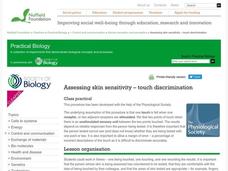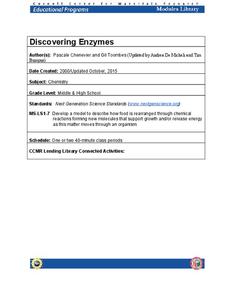Curated OER
Skin Cancer Lesson Plan
Skin care is a topic often overlooked in the health curriculum. This should not be the case because most types of skin cancer can be prevented, or if detected early enough, can be successfully treated. So take the time to teach your...
Nuffield Foundation
Assessing Skin Sensitivity—Touch Discrimination
How do we distinguish between the number of things touching our skin? Scholars explore an interesting activity through an experiment. They learn that there must be an unstimulated sensory unit between two touches to distinguish them....
Curated OER
Turtle and Tortoise Preschool Lesson Plan
One of the best parts about teaching the littlest learners is that you can create thematic lessons that use one topic to address every subject. Here is a nice set of thematic teaching ideas that uses turtles and tortoises to teach...
Curated OER
Getting Under Your Skin
Students design advertisements that promote and explain the science of new transdermal drug therapies to the general public.
Cornell University
Discovering Enzymes
Explore the function of enzymes through a series of lab investigations. Learners use household enzymes such as hydrogen peroxide to model the role of enzymes. The enzymes break down proteins with and without a catalyst.
Curated OER
Teaching in the Shared Way of Ghandi and Montessori
In this differentiated lesson, students incorporate different subjects using the Ghandi and Montessori methods instead of the traditional method used in regular schools. In math they investigate shapes, colors and sizes. In writing they...
Curated OER
Nerve Cell Informercials
Young scholars research the structure and function of the nervous system. They prepare a model or representation of neural transmission. Students create an infomercial about nerve cells.
Curated OER
It's Just a Phase They're Going Through!
In this science worksheet, students write about the stages of mitosis. Students prepare an onion slide and examine the cell.Students draw about the stages they see.
Colorado State University
Why Do Raindrops Sometimes Land Gently and Sometimes with a Splat?
A mouse can fall from large heights without injury! Air resistance is a large influence on small falling objects. In an exploratory lesson, young scholars build a raindrop bottle to compare the falling rate of different-sized objects.
Curated OER
Modeling Breathing Action
Students create a model to identify the parts of the human respiratory system. They explore the Functional Electrical Stimulation (FES) and its use as a breathing support strategy. Students explore reflex actions as an involuntary...
Curated OER
Red Wigglers
Students are introduced to the benefits of using Red Wiggler worms to produce compost. They identify the requirements for the worms and the methods to follow in order to produce compost. They draw a picture of a functioning worm bin.
Curated OER
Body Systems
In this body systems lesson, students work in small groups conduct research to become an 'expert' on one of the 7 body systems. Students present their findings to the class via power point, poster, or song.
Curated OER
Movement Across the Membrane (Diffusion)
Learners investigate the concept of diffusion and how materials enter and leave a cell. In this movement across a membrane lesson plan, students use perfume, food coloring in water and a sugar cube in water to observe diffusion. They...
Curated OER
Trout Cookies
Learners explore the external anatomy of a fish. In this anatomy and adaptations lesson, students look at an image of a trout and identify its various external features including fins, eyes, spots, parr marks and lateral line. Learners...
Curated OER
Role Models
Students consider what makes a role model. In this positive qualities lesson, students read and discuss several books that have characters describing themselves in a positive manner. Students illustrate a self portrait, remembering to...
Curated OER
Esperanza Rising: Lesson 8
Sixth graders complete activities with the book Esperanza Rising by Pam Munoz Ryan. In this literature lesson, 6th graders read Chapter 8 of the book and discuss the chapter. They practice putting events in sequence and record new...
Curated OER
Check Out Lights and Shields with Beads
Students explore Ultraviolet detecting beads and conduct several investigations with them. In this investigative lesson students participate in an experiment to see the harmful effects of UV light and discuss their findings.
Curated OER
The Global Grapefruit - Maps vs Globes
Students tell how maps differ from globes, state some characteristics of 3 different types of map projections, and realize that distortions are inherent in various systems of map projections.
Curated OER
How Do Cells Reproduce?
Learners discuss the importance of reproduction of cells. They identify and describe the stages of Mitosis. They discover what happens to chromosomes and DNA during reproduction.
Curated OER
Graph Those Stickers!
Students graph fruit. In this graphing lesson students create a graph using fruit label stickers. Students place a sticker on the graph when the fruit has been consumed.
Curated OER
"From farm to plate"
Learners identify sources of food and the bacteria associated with them. They comprehend how bacteria in the food chain can cause disease. Students comprehend the importance of proper food-hygiene practices throughout the many stages of...
Curated OER
How Does Human Respiration Relate to Radon?
Learners examine the role of human respiration and how it relates to radon. They identify damage to the lung from the exchange of carbon dioxide and oxygen. They work together to complete a lab activity and worksheet.





















